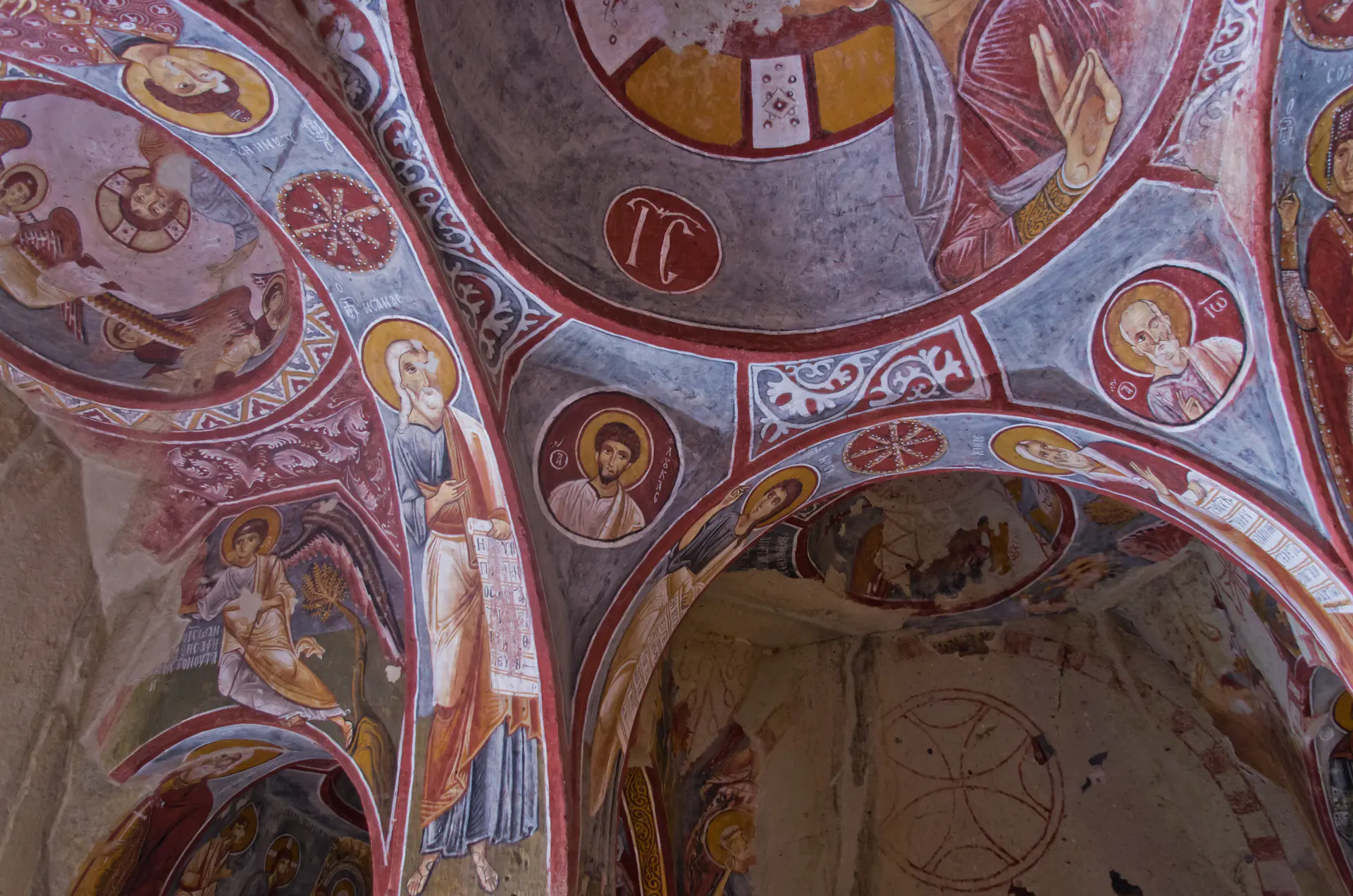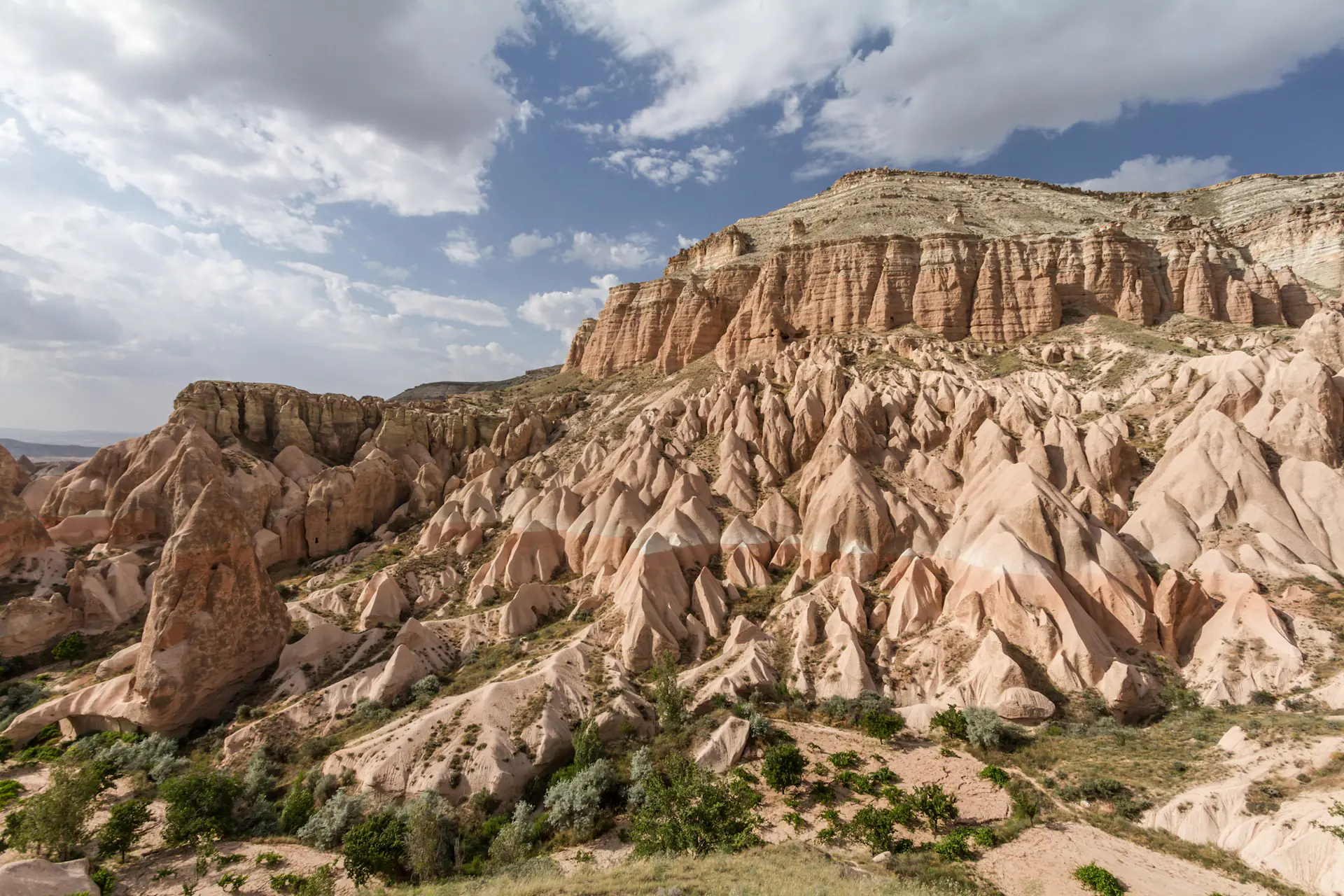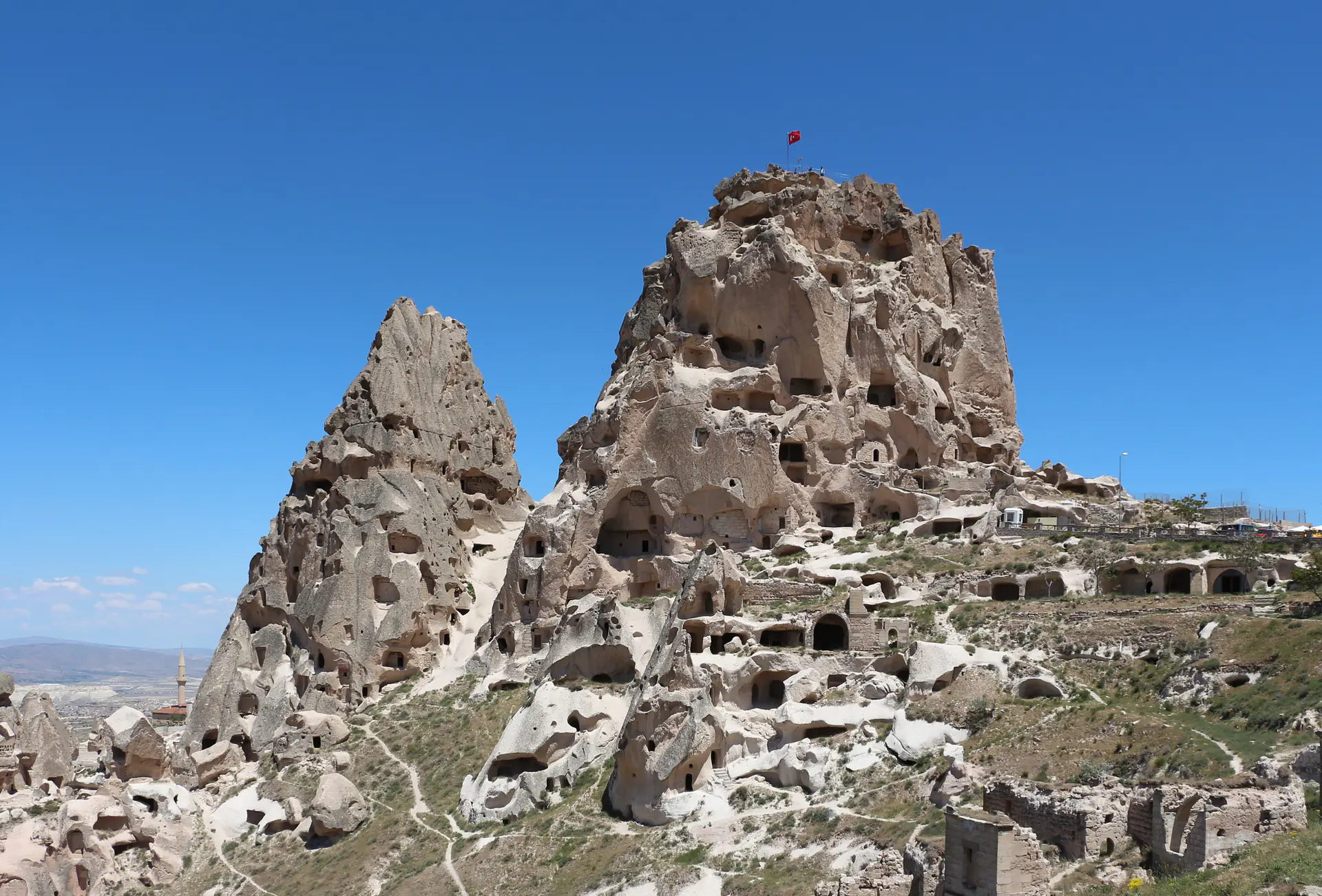
Cappadocia: Fairy Chimneys, Cave Churches & Hot Air Balloons
Byzantine Cave Architecture in Volcanic Landscape
About This Site
Volcanic eruptions sculpted Cappadocia's landscape millions of years ago, covering the region with soft volcanic tuff that erosion carved into surreal fairy chimneys, pinnacles, and mushroom-shaped formations creating one of Earth's most extraordinary geological spectacles. Byzantine Christians established monastic communities from the 4th century onwards, carving elaborate underground cities descending eight levels to 85 meters depth at Derinkuyu that housed up to 20,000 people during invasions, while constructing over 200 rock-hewn churches decorated with exceptional post-Iconoclastic frescoes from the 10th-12th centuries in the Göreme valley. These troglodyte inhabitants hollowed entire villages from volcanic rock, integrating spiritual art within geological formations through innovative cave architecture that demonstrates extraordinary human adaptation to the otherworldly landscape sustained across sixteen centuries from the Byzantine period through Ottoman rule.
Why It Matters
This exceptional mixed heritage site demonstrates both superlative natural beauty through extraordinary volcanic formations and outstanding human cultural achievement through Byzantine cave architecture. Cappadocia preserves unique testimony to traditional troglodyte civilization adapting spiritual, domestic, and defensive needs to geological landscape, creating harmonious synthesis between natural phenomena and human ingenuity sustained across sixteen centuries.
Planning Your Trip
Essential information for visiting this destination
Getting There
Domestic flights from Istanbul reach Kayseri Erkilet Airport 75 kilometers east or Nevşehir Kapadokya Airport 40 kilometers north with shuttle buses and transfers serving Göreme, Urgüp, and Üçhisar cave towns. Kayseri airport offers more frequent Istanbul connections while Nevşehir provides closer proximity with shorter transfer times. Long-distance buses from Istanbul take 10-12 hours overnight, while regional buses connect Cappadocia to Ankara and Konya. Within Cappadocia, rental cars provide flexibility for exploring scattered valleys and underground cities though tour operators offer comprehensive day trips.
Where to Stay
Göreme village center positions visitors among fairy chimneys with budget to mid-range cave hotels carved from volcanic rock, featuring atmospheric stone rooms and convenient walking access to Open Air Museum and valley trails. Central location provides easy balloon launch viewing while maintaining authentic village atmosphere. Üçhisar castle village offers upscale cave hotels with panoramic valley views from elevated positions, delivering quieter atmosphere away from Göreme tourist concentration. Boutique properties provide luxury amenities within historic cave structures though requiring transport for valley exploration. Urgüp town 6 kilometers east balances cave heritage with modern infrastructure, offering varied accommodation from traditional pensions to luxury hotels with convenient access to underground cities and Avanos pottery town. More spacious than Göreme while maintaining character.
Where to Eat
Cappadocian cuisine features mantı Turkish dumplings with yoghurt sauce and butter, testi kebap slow-cooked meat in sealed clay pots dramatically broken tableside releasing aromatic steam and theatrical presentation, and gözleme savoury flatbreads prepared fresh before diners on traditional griddles. Local wineries produce distinctive Cappadocia wines from volcanic soil vineyards including Emir and Narince grape varieties cultivated for centuries in this unique terroir. Traditional pottery kebabs in Avanos pottery town and farm-to-table restaurants showcase regional produce including dried fruits, honey, and seasonal vegetables. Cave restaurants in converted historic structures enhance dining atmospheres with authentic stone interiors and traditional Turkish hospitality creating memorable culinary experiences.
Things to Do
Hot air balloon flights cost €150-200 ($177-236 USD) for standard 1-hour sunrise flights carrying 16-20 passengers, or €250-300 ($295-354 USD) for deluxe flights with 8-12 passengers offering more space and champagne breakfast. Book 2-3 months ahead for April-October peak season--flights cancel frequently due to wind conditions requiring flexible schedules. Sunrise launches at 5-6am depending on season. Göreme Open-Air Museum entry costs ₺450 ($13 USD) with Dark Church supplement ₺450 ($13 USD) additional for best-preserved frescoes absolutely worth the extra cost. Combined Museum Pass covering multiple sites costs ₺1,200 ($35 USD) valid 72 hours. Free entry first Saturday of each month (expect crowds). Underground cities: Derinkuyu costs ₺300 ($9 USD), Kaymaklı ₺300 ($9 USD), both featuring multi-level subterranean refuges. Ihlara Valley entry ₺150 ($5 USD) for 16-kilometer canyon hiking past Byzantine churches. Uçhisar Castle ₺100 ($3 USD) for panoramic summit views. Guided day tours cost €30-50 ($35-59 USD) per person for group tours covering 3-4 major sites with lunch included, or €100-150 ($118-177 USD) for private tours with flexible itineraries. Red Tour visits Göreme Museum, Uçhisar, and valleys; Green Tour covers Derinkuyu, Ihlara Valley, and Selime Monastery. Hiking guides cost €70-100 ($83-118 USD) for full-day private valley treks revealing hidden cave churches and geological formations. Self-guided hiking is free--Rose Valley, Love Valley, and Pigeon Valley trails well-marked. ATV tours cost €30-40 ($35-47 USD) for 2-hour sunset valley safaris, €60-70 ($71-83 USD) for full-day adventures. Horseback riding costs €40-60 ($47-71 USD) for 2-3 hour rides through valleys and past fairy chimneys. Pottery workshops in Avanos cost €20-30 ($24-35 USD) for 1-2 hour sessions learning traditional techniques at ancient pottery town. Turkish bath (hamam) experiences cost €30-60 ($35-71 USD) including scrub, massage, and traditional foam wash. Wine tasting tours cost €50-70 ($59-83 USD) visiting volcanic soil vineyards producing Emir and Narince grape varieties. Whirling dervish ceremonies cost €15-20 ($18-24 USD) for traditional Sufi spiritual performances.
Travel Essentials
International eSIM cards provide data connectivity throughout Cappadocia region, enabling navigation apps, balloon flight confirmations, and real-time weather updates while avoiding expensive international roaming charges. Comprehensive travel insurance covering hot air ballooning activities essential as standard policies may exclude aerial adventures requiring specific coverage verification. Book balloon flights months ahead for peak April-May and September-October seasons when stable weather conditions maximise flight probability. Flights frequently cancel due to wind conditions requiring flexible schedules. Pack layers for dramatic temperature variations between predawn balloon launches and midday heat exceeding 30°C in summer. Sturdy walking shoes essential for uneven volcanic terrain and underground city explorations. Winter December-February brings snow creating ethereal landscapes though limiting balloon operations. Respect historical sites by not touching fragile frescoes or removing geological samples.
Loading map...
Visitor Information
Everything you need to know for your visit
What to Bring
Sturdy walking shoes for rocky terrain and uneven cave floors. Layers for pre-dawn balloon launches (5-10°C cooler). Sun protection (hat, sunscreen) for valley hikes. Water bottles (hydration essential). Camera with extra batteries for extensive photography opportunities.
Accessibility
Cave churches involve stairs and uneven surfaces unsuitable for wheelchairs. Underground cities require moderate fitness navigating narrow passages. Limited wheelchair access.
Safety Tips
Wear sturdy footwear for rocky terrain. Stay hydrated. Balloon flights cancel frequently due to weather.
Wonders of Cappadocia

Hot Air Balloon Flights Over Fairy Chimneys
Experience Cappadocia's most iconic activity floating silently above otherworldly landscape at sunrise, when hundreds of colorful balloons drift over valleys studded with fairy chimneys, cave dwellings, and volcanic pinnacles. Professional pilots navigate gentle winds showcasing panoramic vistas of Rose Valley's pink-hued formations, Göreme's honeycombed cliffs, and distant Mount Erciyes volcano. The one-hour flight reveals the extraordinary scale of geological erosion creating this surreal terrain. Sunrise light transforms rock colors from grey through gold, pink, and orange hues. Following gentle landing in agricultural fields, traditional champagne celebrations toast successful flights while breakfast spreads feature local specialties, creating unforgettable morning combining natural beauty with Turkish hospitality. Pro tip: Book balloon flights 2-3 months ahead for April-October peak season--flights frequently cancel due to wind conditions, so schedule them for your first full day with flexible backup days available, never your final morning before departures.

Göreme Open-Air Museum Byzantine Frescoes
This remarkable monastic complex preserves numerous rock-hewn churches and chapels decorated with exceptional Byzantine frescoes dating from the 10th-13th centuries. These represent the finest examples of post-Iconoclastic Christian art in Anatolia. The Dark Church (Karanlık Kilise) contains extraordinarily well-preserved paintings depicting biblical scenes in vibrant blues, reds, and gold leaf, protected by minimal light exposure throughout centuries. Apple Church (Elmalı Kilise) showcases intricate geometric patterns alongside narrative frescoes illustrating Christ's life, while Buckle Church (Tokalı Kilise) features elaborate multi-chamber decoration spanning barrel-vaulted ceilings and walls. These cave sanctuaries reveal how Byzantine monks adapted volcanic tuff into sacred spaces, carving columns, apses, and domes from living rock before adorning surfaces with theological artistry combining Eastern Orthodox tradition with Cappadocian innovation. Pro tip: Visit at 8am opening before tour buses arrive (10am-2pm)--the Dark Church requires extra ₺450 ($13 USD) beyond museum entry but contains Cappadocia's finest preserved frescoes, absolutely worth the supplement for vibrant 900-year-old colors.

Derinkuyu Underground City
Descend into one of Cappadocia's most astonishing achievements--a subterranean city extending eight levels to 85 meters depth, capable of sheltering up to 20,000 people during extended sieges. This extraordinary excavation features ingenious ventilation shafts ensuring fresh air circulation, storage rooms preserving food supplies, wine presses, stables, chapels, and defensive systems including massive rolling stone doors sealing passages against invaders. The interconnected tunnel network linked multiple underground cities across the region, providing escape routes. Walking through narrow passages and chambers carved entirely from volcanic tuff reveals sophisticated urban planning and engineering prowess, with wells accessing deep water sources and communal spaces maintaining social cohesion during months-long refuge. Pro tip: Visit in the morning (9-11am) before claustrophobic afternoon crowds overwhelm the narrow tunnels--the descent requires moderate fitness and isn't suitable for those with mobility issues, claustrophobia, or back problems navigating low passages.

Rose Valley and Pigeon Valley Hiking
Explore Cappadocia's dramatic valleys on foot, traversing landscapes where erosion sculpted volcanic rock into fantastical formations while revealing hidden cave churches adorned with ancient frescoes. Rose Valley earns its name from sunset light transforming pink-hued tuff formations into glowing spectacle, while moderate trails pass numerous Byzantine chapels including the Column Church featuring well-preserved paintings. Pigeon Valley connects Göreme to Uçhisar through a scenic gorge punctuated by thousands of pigeon houses carved into cliff faces--vital for collecting guano fertilizer. The trails wind between towering fairy chimneys and past cave dwellings offering glimpses of traditional troglodyte life. Spring wildflowers carpet valley floors while autumn grape harvests dot terraced vineyards. Pro tip: Start Rose Valley hikes at 4pm arriving at the main viewpoint by 6pm for spectacular sunset photography (5-6pm in winter)--the pink tuff formations glow magnificently in golden hour light, and you'll avoid the midday heat that makes summer hiking oppressive.

Uçhisar Castle Rock Fortress
Ascend Cappadocia's highest point to Uçhisar Castle, a natural rock citadel rising 60 meters above the surrounding plateau, honeycombed with rooms, tunnels, and chambers carved throughout the volcanic cone across centuries. This strategic fortress served defensive purposes from Byzantine through Ottoman periods, with multiple levels connected by internal staircases offering protected refuge. Climbing to the summit rewards visitors with spectacular 360-degree panoramas encompassing Göreme valley's fairy chimneys, Mount Erciyes volcano towering 3,917 meters east, and agricultural terraces stretching toward distant horizons. The castle's exterior reveals hundreds of carved openings where pigeon houses create intricate patterns. Sunset visits prove particularly popular when golden light illuminates the landscape while villages below begin evening illumination. Pro tip: Arrive 45 minutes before sunset to secure summit viewing spots before crowds--on clear mornings you can watch dozens of hot air balloons launch from this elevated vantage point around sunrise, creating equally spectacular photography opportunities without the sunset crowds.
Historical Context
Volcanic Formation (10-2 Million Years Ago)
Volcanic eruptions from Mount Erciyes and Mount Hasan deposited thick layers of volcanic ash and lava across Central Anatolia. Subsequent erosion by wind, water, and temperature fluctuations sculpted soft tuff into fairy chimneys, valleys, and caves enabling future human habitation.
Hittite and Persian Periods (2000 BCE-4th Century CE)
Early civilizations recognized Cappadocia's strategic importance and defensive potential. Hittites established settlements utilising natural caves. Persians named the region "Katpatuka" (Land of Beautiful Horses). Early Christians began seeking refuge in remote valleys during Roman persecution.
Byzantine Monastic Flourishing (4th-11th Centuries)
Christian monks established extensive monastic communities carving churches, refectories, and cells from volcanic rock. Post-Iconoclastic period (843 CE onwards) witnessed remarkable fresco creation in cave churches. Underground cities expanded providing refuge during Arab raids, becoming sophisticated subterranean settlements.
Seljuk and Ottoman Rule (11th-20th Centuries)
Turkish Seljuk conquest transformed Cappadocia while preserving Christian communities and cave architecture. Ottoman period saw continued troglodyte habitation alongside surface development. Greek Orthodox populations maintained cave churches until 1923 population exchange, after which sites faced abandonment and deterioration.
UNESCO Recognition and Tourism (1985-Present)
World Heritage inscription catalysed conservation programs protecting Byzantine frescoes and geological formations. Hot air ballooning industry emerged creating iconic Cappadocia experience. Cave hotels transformed abandoned dwellings into boutique accommodation. Mass tourism presents ongoing conservation challenges requiring sustainable management balancing preservation with economic development.
Conservation
Current Status
UNESCO World Heritage Committee monitors Cappadocia through periodic reporting while Turkish Ministry of Culture and Tourism implements conservation programs protecting Byzantine frescoes, regulating tourism development, and preserving geological formations against erosion and human impact.
Challenges
- Mass tourism traffic overwhelming fragile cave churches and vulnerable rock formations
- Erosion rates accelerated by climate change impacts and visitor foot traffic
- Unauthorised development projects threatening landscape integrity and protected heritage viewsheds
- Vandalism and graffiti continue damaging Byzantine frescoes despite protective measures
- Hot air balloon operations requiring safety oversight and environmental regulation
Conservation Efforts
- Göreme Open-Air Museum implements visitor capacity limits and protective barriers around vulnerable frescoes
- Geological monitoring tracks erosion rates while stabilisation projects protect critical formations from collapse
- Heritage Impact Assessments required for all development proposals within protected zone boundaries
- Turkish Civil Aviation Authority regulates balloon operations enforcing strict safety standards and flight path restrictions
- International conservation partnerships restore Byzantine frescoes using advanced techniques while training local specialists
Frequently Asked Questions
Absolutely - sunrise balloon flights showcase hundreds of colorful balloons floating above fairy chimneys ($154-295 USD / €130-250 per person). Book 2-3 months ahead for April-October peak season when flights sell out. Flights cancel frequently due to weather conditions; maintain flexible schedules allowing multiple days for contingencies.
Museum entries cost $3-13 USD (₺100-450) per site. Hot air balloon flights represent main expense at $154-295 USD (€130-250) per person. Budget travelers spend $236-331 USD (€200-280) for 3 days. Mid-range visitors pay $531-709 USD (€450-600) including balloon flights and tours. Premium experiences cost $945-1,417+ USD (€800-1,200+) with luxury cave hotels and private guides.
Advance booking essential for April-October peak season when popular properties fill 3+ months ahead. Göreme village offers budget $35-59 USD (€30-50), mid-range $83-142 USD (€70-120), luxury $177-354+ USD (€150-300+) per night carved from volcanic rock. Last-minute bookings possible November-March low season though choice diminishes significantly.
Direct flights operate daily from Istanbul airports to Kayseri (70 kilometers) or Nevşehir (40 kilometers) airports, requiring 1.5 hours flying time. Overnight buses provide economical alternative requiring 10-12 hours. Many visitors combine Cappadocia with Pamukkale or Mediterranean coast creating circular Turkey itinerary.
Numerous boutique cave hotels offer authentic troglodyte accommodation with modern amenities throughout Göreme, Uçhisar, and Ortahisar. These restored cave dwellings maintain natural thermal regulation providing cool summers and warm winters. Advance booking (2-3 months) essential for peak season (April-June, September-October) when popular properties fill completely.
Rose Valley provides spectacular sunset views with pink-hued rock formations and numerous cave churches accessible via moderate trails. Love Valley features dramatic phallic-shaped fairy chimneys along easy walking paths. Ihlara Valley offers riverside canyon hiking past Byzantine frescoed churches extending 16 kilometers.
Fairy chimneys are tall, cone-shaped rock formations created through millions of years of erosion. Volcanic eruptions deposited soft volcanic tuff layers topped by harder basalt caps. Wind and water eroded softer rock while harder caps protected material beneath, creating mushroom-shaped pillars.
Derinkuyu, the largest excavated underground city, descends eight levels reaching 85 meters depth with capacity for 20,000 residents. Kaymaklı extends five accessible levels to 40 meters. These subterranean refuges featured ventilation shafts, storage rooms, chapels, and defensive rolling stone doors.
UNESCO World Heritage Criteria
Inscribed in 1985, this site meets 4 of UNESCO's 10 criteria for Outstanding Universal Value
Criterion (i): Masterpiece of human creative genius
Cappadocia's Byzantine cave churches contain exceptional rock-cut architecture and post-Iconoclastic frescoes representing masterpieces of human creative genius. The integration of spiritual art within geological formations demonstrates extraordinary artistic achievement adapting religious expression to natural landscape.
Criterion (iii): Testimony to cultural tradition
The rock-hewn sanctuaries, monastic complexes, and underground cities provide unique testimony to Byzantine civilization during the post-Iconoclastic period (9th-11th centuries). These troglodyte settlements preserve exceptional evidence of traditional human habitat dating from the 4th century through Ottoman periods.
Criterion (v): Outstanding traditional human settlement
Cappadocia exemplifies outstanding traditional human settlement adapting to extraordinary volcanic landscape through innovative troglodyte architecture. The region demonstrates vulnerable land-use practices where geological erosion, human habitation, and agricultural terraces created distinctive cultural landscape now threatened by modernisation.
Criterion (vii): Contains superlative natural phenomena
The Göreme valley showcases superlative natural phenomena through extraordinary volcanic rock formations sculpted by erosion into fairy chimneys, pinnacles, and otherworldly landscapes. This geological spectacle of exceptional natural beauty results from millions of years of volcanic activity and weathering processes.
Image & Content Attribution
Research & Content Sources
Photography & Visual Media
Last updated: 2 November 2025